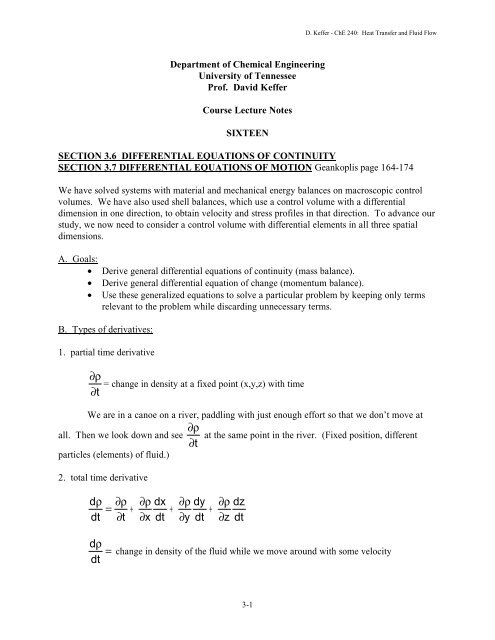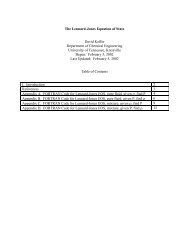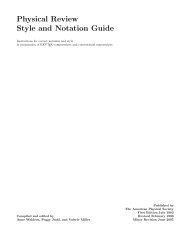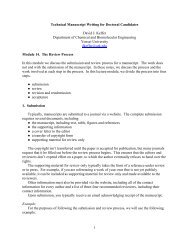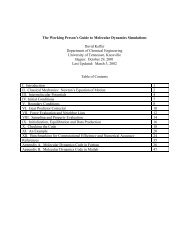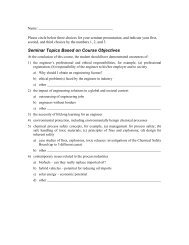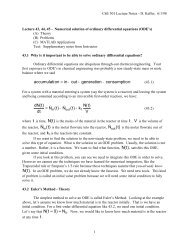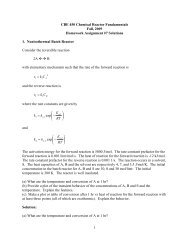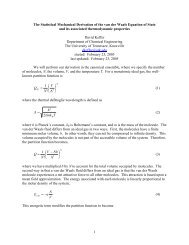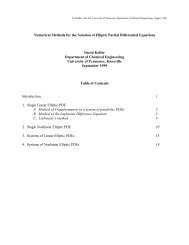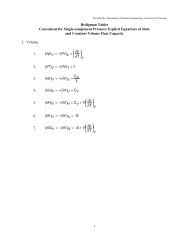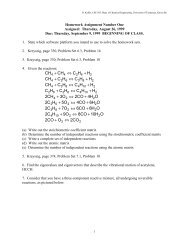tâ Ïâ tâ Ïâ = Ï dt d
tâ Ïâ tâ Ïâ = Ï dt d
tâ Ïâ tâ Ïâ = Ï dt d
You also want an ePaper? Increase the reach of your titles
YUMPU automatically turns print PDFs into web optimized ePapers that Google loves.
D. Keffer - ChE 240: Heat Transfer and Fluid FlowDepartment of Chemical EngineeringUniversity of TennesseeProf. David KefferCourse Lecture NotesSIXTEENSECTION 3.6 DIFFERENTIAL EQUATIONS OF CONTINUITYSECTION 3.7 DIFFERENTIAL EQUATIONS OF MOTION Geankoplis page 164-174We have solved systems with material and mechanical energy balances on macroscopic controlvolumes. We have also used shell balances, which use a control volume with a differentialdimension in one direction, to obtain velocity and stress profiles in that direction. To advance ourstudy, we now need to consider a control volume with differential elements in all three spatialdimensions.A. Goals:• Derive general differential equations of continuity (mass balance).• Derive general differential equation of change (momentum balance).• Use these generalized equations to solve a particular problem by keeping only termsrelevant to the problem while discarding unnecessary terms.B. Types of derivatives:1. partial time derivative∂ ρ = change in density at a fixed point (x,y,z) with time∂tWe are in a canoe on a river, paddling with just enough effort so that we don’t move at∂ρall. Then we look down and see at the same point in the river. (Fixed position, differentparticles (elements) of fluid.)2. total time derivative∂tdρ=<strong>dt</strong>∂ρ+∂ t∂ρ∂ xdx<strong>dt</strong>+∂ρ∂ ydy<strong>dt</strong>+∂ρ∂ zdz<strong>dt</strong>dρ<strong>dt</strong>=change in density of the fluid while we move around with some velocity3-1
D. Keffer - ChE 240: Heat Transfer and Fluid Flowv⎡dx=⎢⎣<strong>dt</strong>dy<strong>dt</strong>Tdz⎤<strong>dt</strong> ⎥⎦We are in a canoe on a river, paddling around, maybe cross-stream, maybe upstream, with∂ρa given velocity, v , a vector. Then we look down and see at different points in river anddifferent particles of the fluid. (Different position, different particles (elements) of fluid.)3. Substantial time derivative (a subset of total time derivatives)∂tDρ=Dt∂ρ+∂ t∂ρv∂ xx+∂ρv∂ yy+∂ρv∂ zz=∂ρ+∂ tv ⋅∇ρDρDtv ===change in density of the fluid while moving with the fluid velocity[ v v v ] TxyzWe are in a canoe on a river, allowing ourselves to move with the river (no paddling).∂ρThen we look down and see at different point in river but for the same particle of the fluid.(Different position, same particles (elements) of fluid.)∂tC. Linear Algebra and Vector Calculus Operations:1. Gradient of a scalar⎡∂ρ∇ρ = ⎢⎣∂x∂ρ∂ yT∂ρ⎤∂ z⎥⎦The gradient of a scalar is a 3x1 vector of the derivative of that scalar in all spatialdimensions.2. divergence of a vector∇ ⋅ v =∂ v∂ xx+∂ vy∂ y+∂ v∂ zz3-2
D. Keffer - ChE 240: Heat Transfer and Fluid FlowThe divergence of a vector is a scalar, representing the dot product of the gradientoperator and the vector.3. divergence of a matrix∇ ⋅τ =⎡∂τ⎢⎢∂ x⎢∂τ⎢ ∂ x⎢⎢∂τ⎢⎣∂ xxxxyxz+++∂τyx∂ y∂τyy∂ y∂τyz∂ y+++∂τ∂ z∂τzxzy∂ z∂τ∂ zzz⎤⎥⎥⎥⎥⎥⎥⎥⎦The divergence of a 3x3 matrix is a 3x1 vector, representing the dot product of thegradient operator and the matrix.4. Laplacian of a scalar∇2ρ =2∂ ρ+2∂ x2∂ ρ+2∂ y2∂ ρ∂ z2This is a scalar. The Laplacian is the sequential operation of first the gradient operator and thenthe divergence operator.Check out some rules of vector algebra and vector calculus in equations (3.6-4 to equation 3.6-16), Geankoplis, page 166-167.D. Derive the general differential equation of continuityaccumulation = in - out + generation - consumptionDefine differential volume element as shown on page167, Geankoplis.Define the five terms in the mass balance.There is no generation or consumption of the fluid.gen = con =0∂ρ ∂ρacc = V = ∆x∆y∆z∂ t ∂ t3-3
D. Keffer - ChE 240: Heat Transfer and Fluid Flowin= inx+ iny+ inz= Ay−zρvx | x + Ax−zρvy | y + Ax−y= ∆y∆zρvx|x+ ∆x∆zρvy|y+ ∆x∆yρvz|zρvz|zout= ∆y∆zρvx | x+ ∆x+ ∆x∆zρvy| y+∆y+ ∆x∆yρvz | z+∆zPut these five terms in mass balance:∆−∂ρx∆y∆z= ( ∆y∆zρvx | x + ∆x∆zρvy | y + ∆x∆yρvz | z )∂ t( ∆y∆zρv| + ∆x∆zρv| + ∆x∆yv | )xDivide by differential volume:x+ ∆xy y+∆yρzz+∆z∂ρ ⎛ρv=⎜x |∂ t ⎝ ∆x⎛ρv⎜x | x−⎝ ∆xx+ ∆x++ρvρv∆yyy||y∆y+y+∆yρvz |∆z+zρv⎞⎟⎠| z∆zz+ ∆z⎞⎟⎠Rearrange into a form recognizable as the definition of a derivative:−∂ρ=∂ tρvx|x+∆x−∆xρvx|x+ρvy|y+∆y−∆yρvy|y+ρvz|z+∆z −∆zρvz|zTake limits as differential elements approach 0 and apply the definition of the derivative:−∂ρ=∂ t( v ) ∂ρ ( v y ) ∂( ρv)∂ ρ∂ xx+∂ y+∂ zz= ∇ ⋅ρvNow consider the law for the derivative( v ) ∂( v ) ∂( ρ)∂ ρ∂ xx= ρx∂ x+vx∂ xand the same for y and z−Dρ⎛∂v= ρ⎜Dt ⎝ ∂ xx+∂ vy∂ y+∂ v∂ zz⎞⎟⎠3-4
D. Keffer - ChE 240: Heat Transfer and Fluid Flow−Dρ= ρ ∇ ⋅Dt( v)This is the continuity equation.For the case of an incompressible fluid (constant density) at steady or unsteady state:∇ ⋅v = 0This is a mass balance. It may not look like it but it is. Just go back through the derivation andsee that this is nothing but an expression ofaccumulation = in - out + generation - consumptionwhen there is no generation or consumption and when the fluid is incompressible. This equationdoes not assume steady state, even though there is no time derivative in the equation. This is afirst order partial differential equation PDE)Example 3.6-1. page 168The continuity equation can also be expressed in spherical and cylindrical coordinates, which areuseful if you have a system which naturally lends itself to that system, as a circular pipe lends itselfto cylindrical coordinates.In cylindrical coordinates:∂ρ= ∇ ⋅ρ v∂ t− is still true butx = rcosθ, y = r sinθ, and z = zso the continuity equation becomes:−∂ρ 1∂ ρ= ∇ ⋅ρ v =∂ t r ∂ rIn spherical coordinates:∂ρ= ∇ ⋅ρ v∂ t− is still true but( rv ) 1∂( ρv) ∂( ρv)r+r∂θθ+∂ zx = r sinθcosφ, y = r sinθsinφ, and z = rcosθSO:z3-5
D. Keffer - ChE 240: Heat Transfer and Fluid Flowso the continuity equation becomes:−∂ρ 1= ∇ ⋅ρ v =∂ t2r2( r v ) 1 ∂( ρvsinθ) 1 ∂ρ ( )∂ρ∂ rr+r sinθSection 3.7 Now do the same analysis for a momentum balanceθv φ∂θ+r sinθE. Derive the general differential equation of change (momentum balance)accumulation = in - out + generation - consumptionDefine differential volume element as shown on page 167.Momentum is a vector. Since there is no intrinsic difference between x, y, and z coordinates, wecan derive the equation of change for the x-component of momentum and then make analogousstatements about the y and z components. Look only at x-component of momentum∂ ρacc = V∂ t( v ) ∂( ρv)x= ∆x∆y∆z∂ tMomentum can flow in and out by convection:x∂φin= inx+ iny+ inz= A y−zρvxvx | x + A x−zρvxvy | y + A x−y= ∆y∆zρvxvx|x+ ∆x∆zρvxvy|y+ ∆x∆yρvxvz|zρvxvz|zout= ∆y∆zρvx vx| x+ ∆x+ ∆x∆zρvxvy| y+∆y+ ∆x∆yρvxvz| z+∆zMomentum can flow in and out by molecular diffusion:in= inx+ iny+ inz= A y−zτxx| x + A x−zτyx| y + A x−y∆y∆zτxx|x+ ∆x∆zτyx|y+ ∆x∆yτzx|zρτzx|zout= ∆y∆zτxx | x+ ∆x+ ∆x∆zτyx| y+∆y+ ∆x∆yτzx| z+∆zMomentum can be generated in the differential volume by a body force like gravity:gen = Vρg= ∆x∆y∆zρx g x3-6
D. Keffer - ChE 240: Heat Transfer and Fluid FlowMomentum can be generated in the differential volume by a net force acting on the element, dueto the difference in pressures:gen( p − p ) ∆y∆z= x x+∆xPut these five terms in mass balance:∂( ρvx)∆x∆y∆z= ∆y∆zρvxv∂ t− ∆y∆zρvv | + ∆x∆zρv+−+∆y∆zτ∆y∆zτxxxxx||x∆x∆y∆zρgxx+∆xxx+∆x+ ∆x∆zτ+|( p − p ) ∆y∆zxyxy+ ∆x∆zτyx|x+∆xxx|xvy+∆yy|+ ∆x∆yτ+ ∆x∆zρvy+∆yzx|z+ ∆x∆yτzxx|vy|y+ ∆x∆yρvz+∆z+ ∆x∆yρvxvz|z+∆zxvz|zDivide by volume, rearrange, and take limits and apply the definition of the derivative−+( v ) ⎡∂ ( ρvv ) ∂ρ ( v xvy ) ∂( ρvv )∂ ρ∂ t⎛∂τ⎜⎝ ∂ xxxx+=⎢⎣∂τyx∂ y+x∂ xx∂τ∂ zzx+⎞⎟+⎠∂ y∂ p−∂ xρgx+x∂ zz⎤⎥⎦Now, consider again the rule for derivatives of a product:( v v ) ∂( v ) ∂( ρv)∂ ρ x∂ xx= ρvand the same for y and z, i.e.xx∂ x+vx∂ x( v xvy ) ∂( v y ) ∂( ρv)∂ρ∂ y= ρvx∂ y+vy∂ y( v v ) ∂( v ) ∂( ρv)∂ ρ x∂ zz= ρvxz∂ z+vz∂ zSubstituting these rules into our momentum balance, we have:xxx3-7
D. Keffer - ChE 240: Heat Transfer and Fluid Flow−+( v )∂ ρ∂ t⎛∂τ⎜⎝ ∂ xxxx+⎡ ∂ x⎢ρvx +∂ x⎢⎢⎢∂= + ρvx∂ y⎢⎢ ∂ z⎢+ ρvx⎣ ∂ z∂τyx∂ y+( v ) ∂ρ ( v )∂τ∂ z( vy) ∂( ρv)( v ) ∂ρ ( v )zx⎞⎟+⎠v++xvvyz∂ p−∂ x∂ xx∂ y∂ zρgxxx⎤⎥⎥⎥⎥⎥⎥⎥⎦Recall, the substantial derivative of the x-momentum component has the definition:( ρv) ∂( ρv) ∂( ρv) ∂( ρv) ∂( ρv)DDtx=∂ tx+∂ xxvx+∂ yxvy+∂ zxvz−⎡⎢ρv⎣( v ) ∂( ρv) ∂( ρv) ∂( ρv)⎡∂ ρ⎢⎣ ∂ txx( v ) ∂( v y ) ∂( v )∂∂ xx++∂ xρvxxvx∂ y++∂ yρvxxvyz∂ z+⎤⎥ +⎦∂ zx⎛∂τ⎜⎝ ∂ xxxv+z⎤⎥⎦=∂τyx∂ y+∂τ∂ zzx⎞⎟+⎠∂ p−∂ xρgx−( ρv)DDtx= ρvx⎛∂τ⎜⎝ ∂ x∂τ∂τ∂ z∂ p∂ xxx yx zx( ∇ ⋅ v) + ⎜ + + ⎟+− ρgx∂ y⎞⎟⎠but using the product rule for differentiation again:( ρv) D( v ) D( ρ)DDtx= ρDtx+vxDtDρDtFrom the mass balance: − = ρ( ∇ ⋅ v)so( ρv) D( v ) D( ρ)DDtx= ρDt( ρv) D( v )DDtx= ρDtxx−+vxvxDt( ⋅ v)ρ ∇3-8
D. Keffer - ChE 240: Heat Transfer and Fluid FlowAnd the momentum balance becomes:−( )D vρDtx+vx⎛∂τ⎜⎝ ∂ x∂τ∂ z∂ p∂ xxx yx zx( v) − ρvx( ∇ ⋅ v) = ⎜ + + ⎟+− ρgxρ ∇ ⋅∂τ∂ y⎞⎟⎠−( )D vρDtx⎛∂τ=⎜⎝ ∂ xxx+∂τyx∂ y+∂τ∂ zzx⎞⎟+⎠∂ p−∂ xρgxThis is the equation of motion in the x-direction. It is a momentum balance.The y- and z-components of the momentum are obtained in a precisely analogous manner.They look like:( )D v y− ρDt( )D v− ρDtz⎛∂τ=⎜⎝ ∂ x⎛∂τ=⎜⎝ ∂ xxyxz+∂τyy∂ y∂τyz∂ ywhich in vector notation looks like:( )+++∂τzy∂ z∂τ∂ zzz⎞⎟+⎠⎞⎟+⎠∂ p−∂ y∂ p−∂ zρgρgD v− ρ = ∇ ⋅τ + ∇p− ρgGeankoplis, 3.7-13DtThis momentum balance is true for any continuous medium.B. Equations for stresses using Newton’s Law of viscosity (page 172-173)1. Shear stress components for Newtonian fluids in rectangular coordinatesSee Geankoplis page 172, eqns (3.7-14 to 3.7-20)2. Shear stress components for Newtonian fluids in cylindrical coordinatesSee Geankoplis page 172-173, eqns (3.7-21 to 3.7-27)3. Shear stress components for Newtonian fluids in spherical coordinatesSee Geankoplis page 173, eqns (3.7-28 to 3.7-34)For the qualitative explanation of the basis of these equations, you must go to “An Introduction toFluid Dynamics” by Stanley Middleman, Wiley, New York, 1998, page 142-143Examine rectangular case: obtain 1-D results from 3-D case by looking at equation 3.7-17 whenthe y component of the velocity is zero.yz3-9
D. Keffer - ChE 240: Heat Transfer and Fluid FlowSubstitute the definitions of the Newtonian stress into the equation of change. Obtain theequation of change for a Newtonian fluid. Example given for x component in rectangularcoordinate system. (3.7-35)( )D vρDtx=+∂ ⎡ ∂ v2x ⎢µ∂ ⎣ ∂ xx∂ ⎡ ⎛∂vz⎢µ⎜∂ ⎣ ⎝ ∂ zx−+2µ ∇ ⋅3∂ v∂ x( v)z⎤⎥+⎦⎞⎤∂ p⎟⎥ − +⎠⎦∂ x∂ ⎡ ⎛∂v⎢µy⎜∂ ⎣ ⎝ ∂ yρgxx+∂ vy∂ x⎞⎤⎟⎥⎠⎦C. Navier-Stokes equations (Equation of change for incompressible Newtonian fluid) (page 174-175)When the density is constant (incompressible) and the viscosity is constant (isothermalconditions), the equations of (3.7-10 to 3.7-13) combined with Newton’s law equations(equations 3.7-14 to 3.7-34) become the Navier-Stokes equations.1. Equations of change for incompressible Newtonian fluid in rectangular coordinatesStart with equation (3.7-35), general equation of change for Newtonian fluid and assume constantdensity:( )D vρDtx=+∂ ⎡ ∂ v2x ⎢µ∂ ⎣ ∂ xx∂ ⎡ ⎛∂vz⎢µ⎜∂ ⎣ ⎝ ∂ zx−+2µ ∇ ⋅3∂ v∂ x( v)z⎤⎥+⎦⎞⎤∂ p⎟⎥ − +⎠⎦∂ x∂ ⎡ ⎛∂v⎢µy⎜∂ ⎣ ⎝ ∂ yρgxx+∂ vy∂ x⎞⎤⎟⎥⎠⎦( )D vρDtx=+⎡ ∂⎢2µ⎣ ∂ x2v x2⎡ ⎛⎢ ⎜∂µ⎢⎣⎝ ∂ z2v x2−+2 ∂µ3 ∂ x( ∇ ⋅ v)⎤⎥+⎦2∂ v ⎞⎤z ⎟∂ p⎥−+∂ z∂x⎠⎥⎦∂ x⎡ ⎛⎢ ⎜∂µ⎢ ⎜⎣ ⎝ ∂ yρgx2v x2+2∂ v ⎞⎤y ⎟⎥∂ y∂x ⎟⎠⎥⎦( )D vρDtx⎡ ∂= ⎢2µ⎣ ∂ x+⎡ ⎛⎢ ⎜∂µ⎢ ⎜⎣ ⎝∂ y2v x22v x2+−2 ∂ ⎛∂vµ3 x⎜∂ ⎝ ∂ x2∂ v ⎞⎤y ⎟⎥+∂ y∂x ⎟⎠⎥⎦x+∂ v⎡ ⎛⎢ ⎜∂µ⎢⎣⎝ ∂ zy∂ y2v x2++∂ v∂ zz⎞⎤⎟⎥⎠⎦2∂ v ⎞⎤z ⎟⎥−∂ z∂x⎠⎥⎦∂ p+∂ xρgx3-10
D. Keffer - ChE 240: Heat Transfer and Fluid Flow( )D vρDtx⎡ ∂= ⎢2µ⎢⎣∂ x+⎡ ⎛⎢ ⎜∂µ⎢ ⎜⎣ ⎝ ∂ y2v x22v x2+−2 ⎛⎜∂µ3 ⎜⎝∂ x2v x22∂ v ⎞⎤y ⎟⎥+∂ y∂x ⎟⎠⎥⎦2∂ v y+ +∂ x∂y⎡ ⎛⎢ ⎜∂µ⎢⎣⎝ ∂ z2v x2+2∂ v ⎞⎤z ⎟⎥∂ x∂z ⎟⎠⎥⎦2∂ v ⎞⎤z ⎟⎥−∂ z∂x⎠⎥⎦∂ p+∂ xρgx( )D vρDtx⎛2⎜∂ v= µ⎝ ∂ x+x2⎡ 2µ ∂ v⎢3 ⎢⎣∂ xx2++2∂ v x+2∂ y2∂ v y+∂ x∂y2x2∂ v∂ z⎞⎟−⎠2∂ v ⎤z⎥∂ x∂z ⎥⎦∂ p+∂ xρgx( )D vρDtx⎛2⎜∂ v= µ⎝ ∂ x+x2+µ ∂ ⎡∂v x⎢3 ∂ x ⎣ ∂ x∂ v∂ y+2x2∂ vy∂ y++2x2∂ v∂ z∂ v∂ zz⎞⎟−⎠⎤⎥⎦∂ p+∂ xρgx( )D vρDtx⎛2⎜∂ v= µ⎝ ∂ xx2+2x2∂ v∂ y+2x2∂ v∂ z⎞⎟−⎠∂ p+∂ xρgx+µ ∂3 ∂ x[ ∇ ⋅ v]From the mass balance, we know that for an incompressible fluid, the divergence of the velocity iszero.( )D vρDtx⎛⎜∂= µ⎝ ∂ x2v x2+∂2v x2∂ y+∂2v x2∂ z⎞⎟−⎠∂ p+∂ xρgxThis is the equation of change for an incompressible Newtonian fluid in the x-direction, usingrectangular coordinates. The y and z equations look like:( )D vρDty⎛⎜∂= µ⎜⎝ ∂ x2v y2+∂2v y2∂ y+∂2v y2∂ z⎞⎟−⎟⎠∂ p+∂ yρgy3-11
D. Keffer - ChE 240: Heat Transfer and Fluid Flow( )D vρDtz⎛⎜∂= µ⎝ ∂ x2v z2+∂2v z2∂ y+∂2v z2∂ z⎞⎟−⎠∂ p+∂ zρgzand the three equations can be expressed in vector notation asρ( v)D 2Dt= µ∇v −∇p+ρg2. Equations of change for incompressible Newtonian fluids in cylindrical coordinatesSee Geankoplis page 174, eqns (3.7-40 to 3.7-42)3. Equations of change for incompressible Newtonian fluids in spherical coordinatesSee Geankoplis page 174-175, eqns (3.7-43 to 3.7-46)3-12


